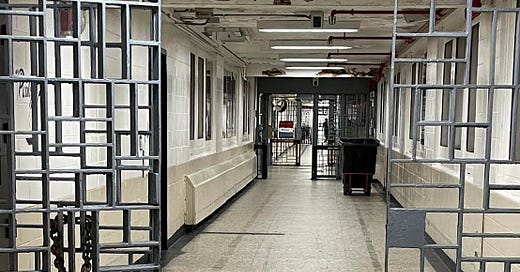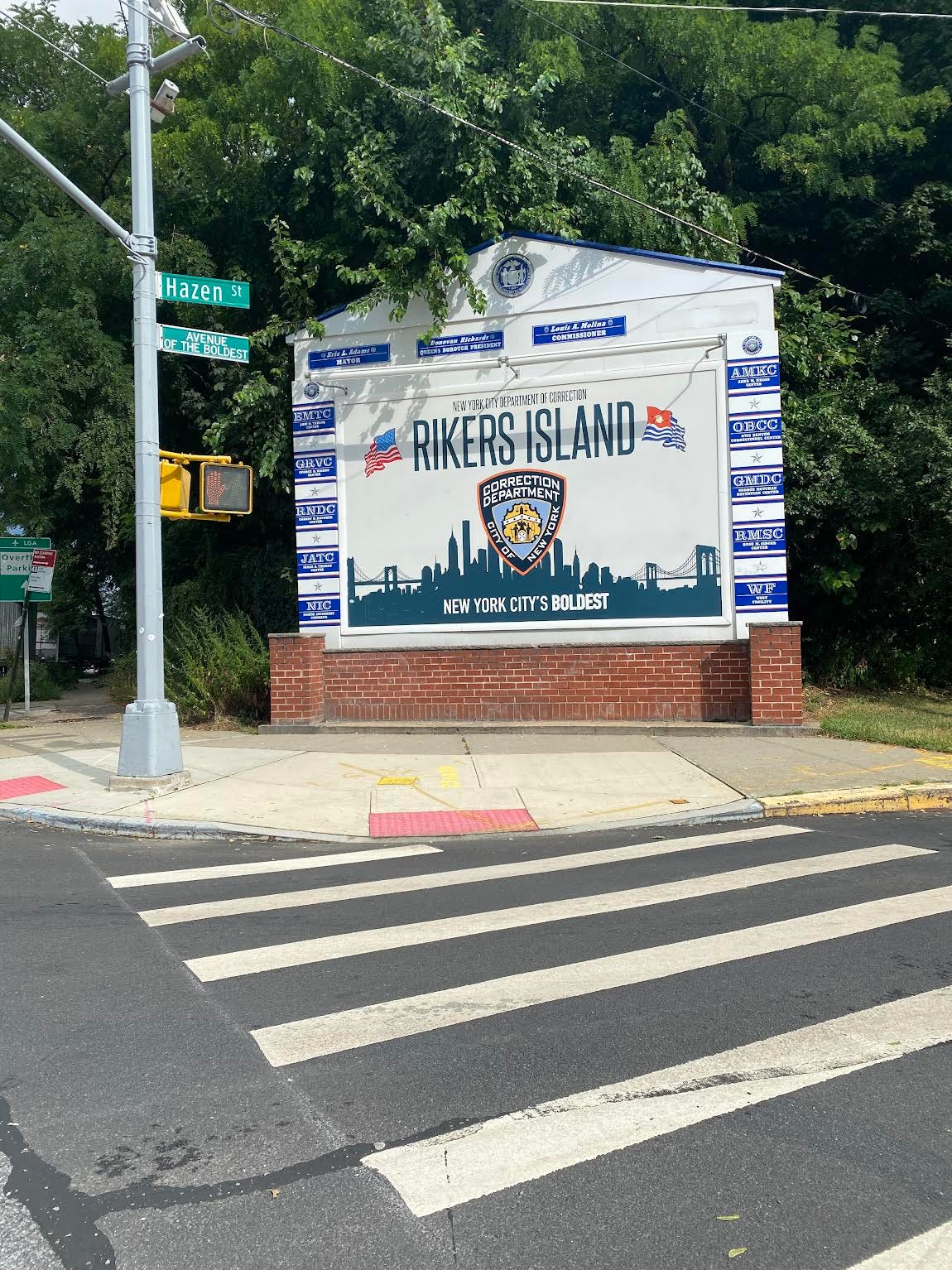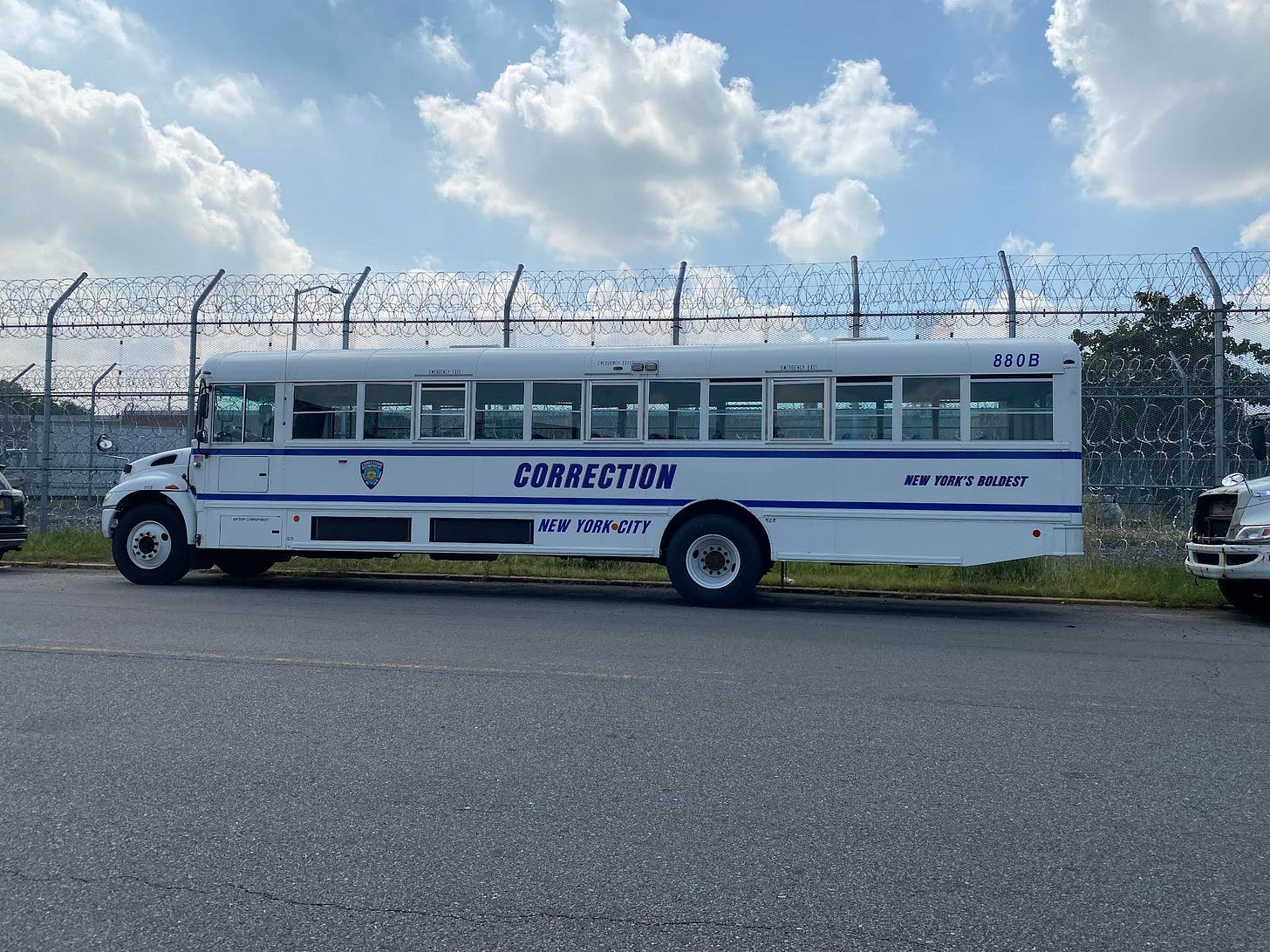Part two of an interview with Patrick Ferraiuolo. Patrick is an NYC Department of Corrections Captain and the President of the Corrections Captain Association. To read part one, click here.
Rikers Island, 2022
Jason: I recently read that the proposed skyscraper jails have an inmate capacity that is significantly smaller than Rikers Island. Is that true?
Pat: The last I heard was all four of the new facilities combined would only house 3,300 inmates in total. Before Adams administration started, we were doing a tour of Rikers one day with a bunch of NY State Assemblymen and that question came up. Some woman from Vincent Shiraldi’s staff gave me an insight that day into how progressives really think.
So I asked her: We currently have 6,100 inmates. If the new capacity for all of the borough-based jails is 3,300, what do we do when the capacity reaches 3,301?
Her answer: that’s not our problem.
The truth is, it is her problem. It becomes everyone’s problem when the city becomes more dangerous. None of us get to live in a bubble. Not me, not her, not my 20-year-old daughter.
Everyone has an opinion about Rikers Island but nobody wants to have a real conversation about how to manage society's most dangerous people. This is the progressive mindset when it comes to Rikers Island. They are gonna scale down the inmate population and don’t care what the repercussions are, even if that means more blood on the streets.
Back to the borough-based facilities, in my opinion, there’s really no need to build the new ones in the suggested new locations. All you have to do is build three new buildings on Rikers Island, keep the best one, build a new mental institution with a 1,000-bed capacity and bring back the procedures that we know worked. Rikers is 413 acres, there’s plenty of space to do everything. A lot of the conversations about why we need to build the new facilities elsewhere are not rooted in reality.
One reason they talk about is how hard it is for inmates to access courts. I worked that job before. We used to have 400 inmates circulate through criminal, narco, family, and supreme court, every single day and never had issues with appearances. Getting inmates to borough facilities has never been a problem. If inmates are on trial and we want to house them closer to that courthouse, there are existing facilities where we can do that. The city already spent untold millions of dollars on these facilities and then closed them. Just open them up. I don’t understand what the problem is.
I am all for using the borough-based facilities to house inmates on trial. You don’t want to bus an inmate every day who’s on a two or three-week trial. It’s unnecessary work for everyone involved, but for the borough-based jails to be the sole prison facilities for all of NYC is ridiculous.
Corrections Bus on Rikers Island, 2022
Jason: Knowing how comfortable inmates are with lighting fires, how do you feel about bringing this population to live in an area as dense as lower Manhattan?
Pat: If you have a fire in one of these proposed skyscraper facilities, everything shuts down. The elevators stop. We had our own fire department on Rikers Island for years but it was shut down through budget cuts. We were never dependent on the fire department to come in and put out a house fire, we did it ourselves, and our staff had to be trained in fire fighting. There is no reason to expect these fires are going to stop once we move this same population to Chinatown.
Also, Rikers has windows with screens for ventilation. The borough-based facilities are not gonna have windows that open, they’ll be security glass windows. The new buildings will rely solely on the air that’s forced into those buildings. When a fire happens they’ll have to shut the ventilation system down to contain it. It’ll also be harder to manage fires in a dense neighborhood like downtown Manhattan, and even harder to manage based on the height of the building. The highest fire ladder in existence can only reach the 13th floor, the Chinatown mega-jail is currently slated to be 40 stories tall (down from 55). They should practice lighting some fires on the 14th floor of the tombs and see how it goes.
Jason: Tell me about the peak of gang activity on Rikers Island.
Pat: There was a major peak of gangs under the Deblasio administration. We had teams under the D.O.C. back then who made some terrible decisions. One of them was to house each individual gang in their own facilities, with the idea that if they were all housed with their friends, maybe violence will decrease.
The gangs became so powerful that they would actually dictate which Corrections Officers were allowed to work in each unit. Inmates were actually running the jail, and it got even worse once Shiraldi became commissioner. Deblasio created this environment where there would be 1-3 Corrections Officers in a unit with 40+ gang members. When Molina took over, one of the first things he did was break up these gangs.
When I was a new captain I had 3,000 inmates in the jail I worked in, and within that population were a certain amount of predators spread out throughout the entire facility. These inmates were dangerous people who preyed on the weak and made life hell for inmates who just want to do their time in peace. I asked the warden to let me house all of the worst inmates together. He said okay, and we proceeded to put the 600 worst inmates in six housing units. I walked in and said to this new group: Congrats, now you all have to sleep with one eye open.
Not allowing gang members to live in concentrated groups is critical to reducing violent incidents. I know it sounds crazy, but putting the dangerous people together while simultaneously splitting up the gangs is a formula that works. We had to mix the Bloods, Crips, ÑETAs, and Latin Kings. Strength in numbers is a real thing, and once we reduced those numbers things got a lot better. There are so many variables to managing this population that nobody thinks about, and for the most part, the media just never wants to hear all the different sides of this story. These are issues that I’ve been dealing with personally for years.
The gang situation is not 100% fixed. You still have gangs, and they are still violent in jail, but it is a lot better under the Adams administration.
Jason: Explain to me some more of the advantages of keeping our prison population at Rikers Island and not in the borough-based facilities.
Pat: It’s been statistically proven that there are career criminals who have neither the interest nor ability to participate in modern society. I know this sounds horrible but there were guys that I knew for years who couldn’t make life work in the streets but were fairly stable within a structured prison routine. They would get out, come back in on a new charge, touch base with me directly, and I’d get them back to working in the kitchen or whatever their old routine was. Unfortunately, it’s a fact, that certain people just cannot function in the outside world. Some people have 4 or 5 kids and there’s just that one kid who chooses a life of crime no matter what the parents do.
Rikers Island, 2022
Jason: Tell me about the drugs and overdoses on Rikers Island.
Pat: Some of the suicides under the Deblasio administration happened in unmanned housing areas. Progressives were outraged that there were no guards on staff, but we weren’t allowed to hire officers, and countless officers were out sick from covid, some scared, and some of them actually dying.
Let’s talk about Fentanyl. One day a reporter called me and said that Rikers has a major Fentanyl crisis but the truth is the whole country is having a Fentanyl crisis and Rikers is not immune to it. For every inmate who overdoses on fentanyl on Rikers Island, there are four individuals who overdose on the streets. A few weeks ago we had two Corrections Officers rushed to the hospital because they were exposed to Fentanyl while opening the mail. People are soaking letters in Fentanyl, it’s in the paper. When an inmate overdoses on Fentanyl it makes the newspapers, but when Corrections Officers almost die by being poisoned with Fentanyl, nobody cares.
Jason: So suicides went up under Deblasio and are now decreasing under the Adams Administration?
Pat: Suicides are down recently, which is great news. It’s just important to remember that suicides aren’t a new thing, nor are they exclusive to jails. Over 500 people committed suicide in NYC in 2020. Sure, sometimes people get sentenced to 25 years and decide they’d rather commit suicide than do the time, but that’s a story that’s been happening forever.
Jason: What does the general public have wrong when it comes to solitary confinement?
Pat: Unfortunately, in prison, you need punitive segregation. Many call it inhumane, but I call it keeping the other inmates safe. These people have no idea what they are talking about. The main problem in Rikers is not how all inmates are treated, it’s how many violent inmates we have and the level of violence they are willing to inflict on other inmates.
Jason: So what you’re saying is punitive segregation is perceived as punishment for an inmate who’s already being punished, but to you, it’s just a necessary step to keep inmates safe.
Pat: Exactly. Corrections officers have a duty to keep inmates safe from predatory inmates. If you’re incarcerated as a detention inmate, you are there for a reason. We both know that. You’re there because you continuously commit crimes, especially today because you can have a rap sheet of 20 crimes before you actually have a bail set on you. But punishment isn’t the right word to describe this scenario, I’d call that justice. Maybe progressives think punitive segregation is punishment, but if those same people were on Rikers Island and were viciously attacked (the way our inmates are attacked), they’d want the attacker locked up right away.
I’d love to be able to say that people today are less violent, that there are no guns and nothing to worry about, but unfortunately that’s not the reality we live in. NYC is becoming increasingly dangerous, crime is growing and criminals are much more emboldened today than they were three years ago.
This concludes part 2 of 4.
To be continued…






